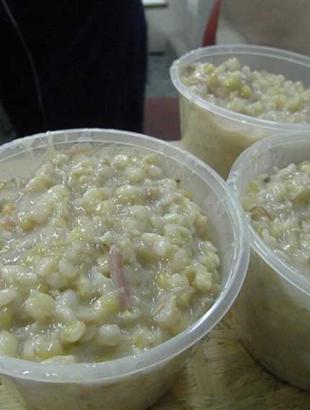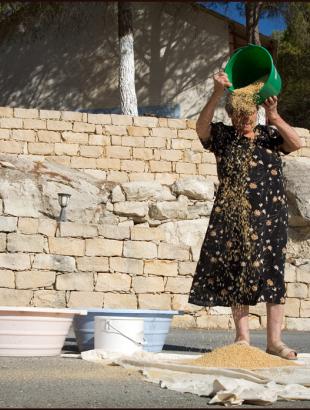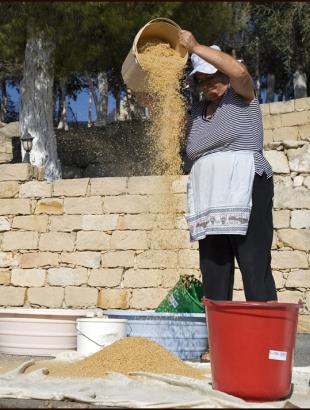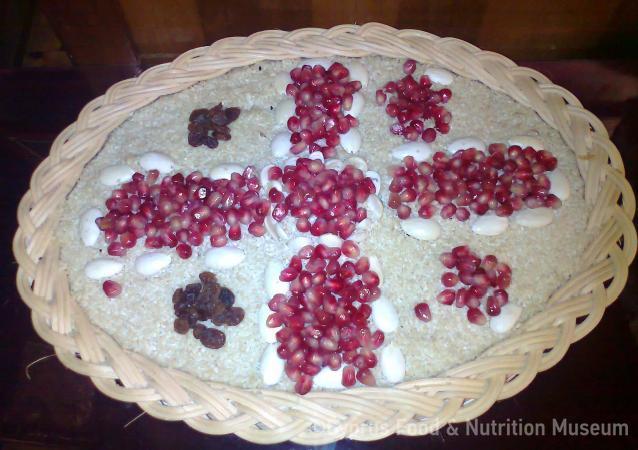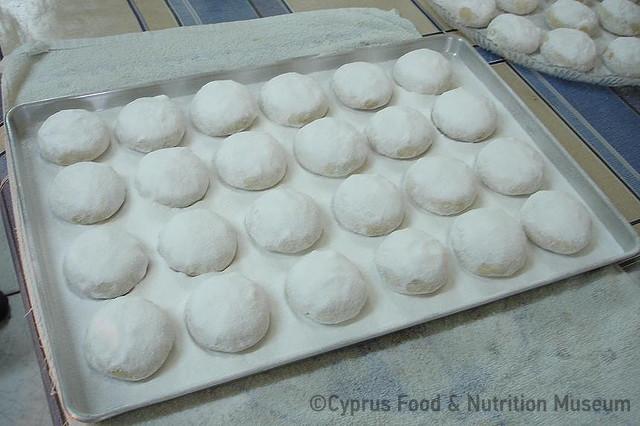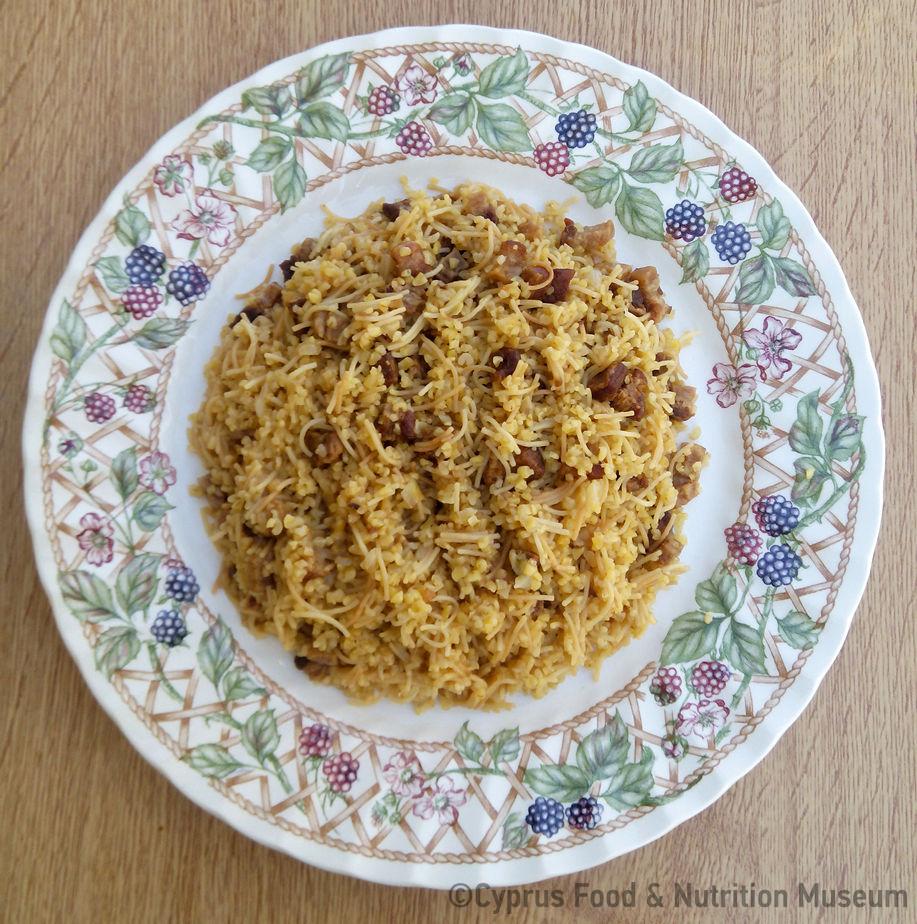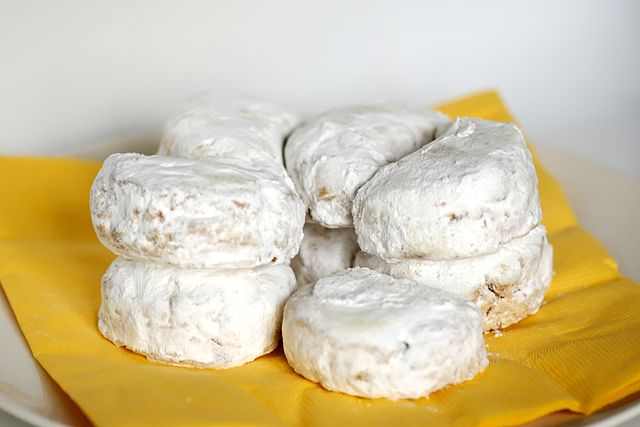A traditional pilaf-like dish made from wheat cooked in meat broth. Resi is directly linked to the Cypriot wedding, since it was offered to the wedding guests at the dinner following the wedding ceremony.
Name - Recipe
Meat with wheat.
Two etymological versions of ressi refer to its deliciousness: according to Constantine G. Yangoullis (2014, article ρέσιν,το, 460) the word ressi comes from the verb to like (in greek aressi), and according to Roy Papangelou (2001) from the verb "resizousin", i.e. to be desired.
Version A:
goat meat or chicken
wheat
salt
lemon
Version B:
2½ kg of pork or lamb, depending on your preference (sheep's
tail "vakla" can be included)
3-4 kg of coarsely ground wheat
salt
water
Version C:
goat meat
4 kg of onions
wheat
salt
Version A:
In a saucepan, boil the meat in water for several hours, until it becomes soft. Once it is tender enough, remove the bones and put the meat back in the pot. Then add the wheat, which has first been passed through the hand grain mill. Add salt and lemon and let it to cook slowly (it is better to use wood fire). (Proof: Anna Nicolaou, 61 years old, Kyperounda - Limassol, at Kurri and Lazarou 2007, unpublished data).
Version B:
Wash the meat very well so that there is not a trace of blood and place it in the bottom of a deep pot. Wash the wheat and place on top of the meat until about 10cm to the rim of the pot. Add water to cover the ingredients. Cook on low heat allowing some distance from the hob. Do not stir, but add water occasionally. When the ingredients begin to cook, start stirring and add the salt. If more water is needed, add a cup at a time from time to time. The aim is that the ingredients melt and become like a thick porridge. Next, remove from the heat and cover the pot so the mixture absorbs all the liquid. Serve the ressin before it cools down. (Ministry of Agriculture 2010, Traditional Cypriot preparations, 20-21).
Version C:
In Limnatis village, Mr. George Zavros prepares ressin for various weddings and events. He was taught by his uncle when he used to go and help him out. On Saturday afternoon he would put goat meat and water into a bronze pot on the fire to boil it. He would add salt and then skim the foam. He would add 4 kilos of sliced onions and let it simmer until Sunday morning. On Sunday morning, he would take the meat out of the pot and remove the bones. Then he would transfer the broth in another pot. He would thoroughly clean the first pot and put the lean meat and the broth in it. He would place the pot on wood fire until the broth comes to a boil. He would wash well the (already ground) wheat and add it to the pot and stir it for 3-4 hours. During the stirring he adds water and salt. At first the heat is high, and then he would lower the heat. In the last hour, ressin is cooked only on coals. Hewould remove the pot from heat and let it sit for 4-5 hours to allow the wheat to absorb the broth. Then, ressin is ready to be served. (Limnatis Community Council, 'Traditional products’).
Boiling.
Functional and symbolic role
It should be mentioned that ressin is still prepared today at traditional Cypriot weddings (Pharmakidis 2002).
Resin was traditionally served at weddings.
The "ritual" of its preparation would begin two or three days before the wedding and was part of the customs of the traditional Cypriot wedding. Resin was a dish also served at Turkish Cypriot weddings.
The wheat would be cleaned and then carried, in hoes covered with red scarves and accompanied by music and songs, to the village fountain. There the girls who were helping in the preparation of the wedding would wash it and then carry it back to the house where it would be laid out to dry. The next day, again with the accompaniment of musical instruments and songs, they would grind it. The grinding was done on the hand mill, which was turned upside down. In this way, the wheat would not become ground but would be peeled and broken slightly. Then it would be roasted. The wheat would be cooked in large pots in meat broth (of the meat which had already been boiled). Some pieces of meat and fat would be left in the pots to cook with the wheat. Various aromatics would be added. Cooking took many hours and required constant stirring with a large wooden spoon. The result was a delicious porridge gel. Today, ressin is still prepared in a few individual cases where the wedding follows the old traditional customs, but the entire old ritual of its preparation is not followed (Limnatis Community Council, 'Traditional products').
Apart from weddings, Turkish Cypriots would also prepare it on the during Bairam festivities and in times of drought (Pharmakidis 2002, 129). During drought, Hoja would recite a prayer and then they would distribute ressi to poor people of the village, regardless of their religion.
Additional information and bibliography
Watch in the link below the song that accompanied the preparation of ressi: http://www.youtube.com/watch?v=406D1HuUc5c.
See article on Ressi in the Food section.
Yangoullis K. G. (2014), Treasury of the Medieval and Modern Cypriot Dialect. Hermeneutic, Etymological, Phraseological and Nomenclatural, Library of Cypriot Folk Poets,74, Nicosia.
Limnatis Community Council, 'Traditional products', http:// www.limnati.org/gr/traditional-products-lgr.
Kourri P. and Lazarou S. (eds.) (2007), Traditional recipes of the village of Kyperounda (unpublished data).
Papangelou R. (2001), The Cypriot Idiom, Iolkos Publications, Nicosia.
Ministry of Agriculture, Natural Resources and Environment, Department of Agriculture (2010), Cypriot traditional preparations, Press and Information Office, Nicosia.
Pharmakidis X. P. (2002), 'Cypriot Delicacies', Folklore Cyprus 32,52, 129.
Stalo Lazarou, Antonia Matala, Dimitra Demetriou, Varvara Yangou, Argyro Xenophontos
